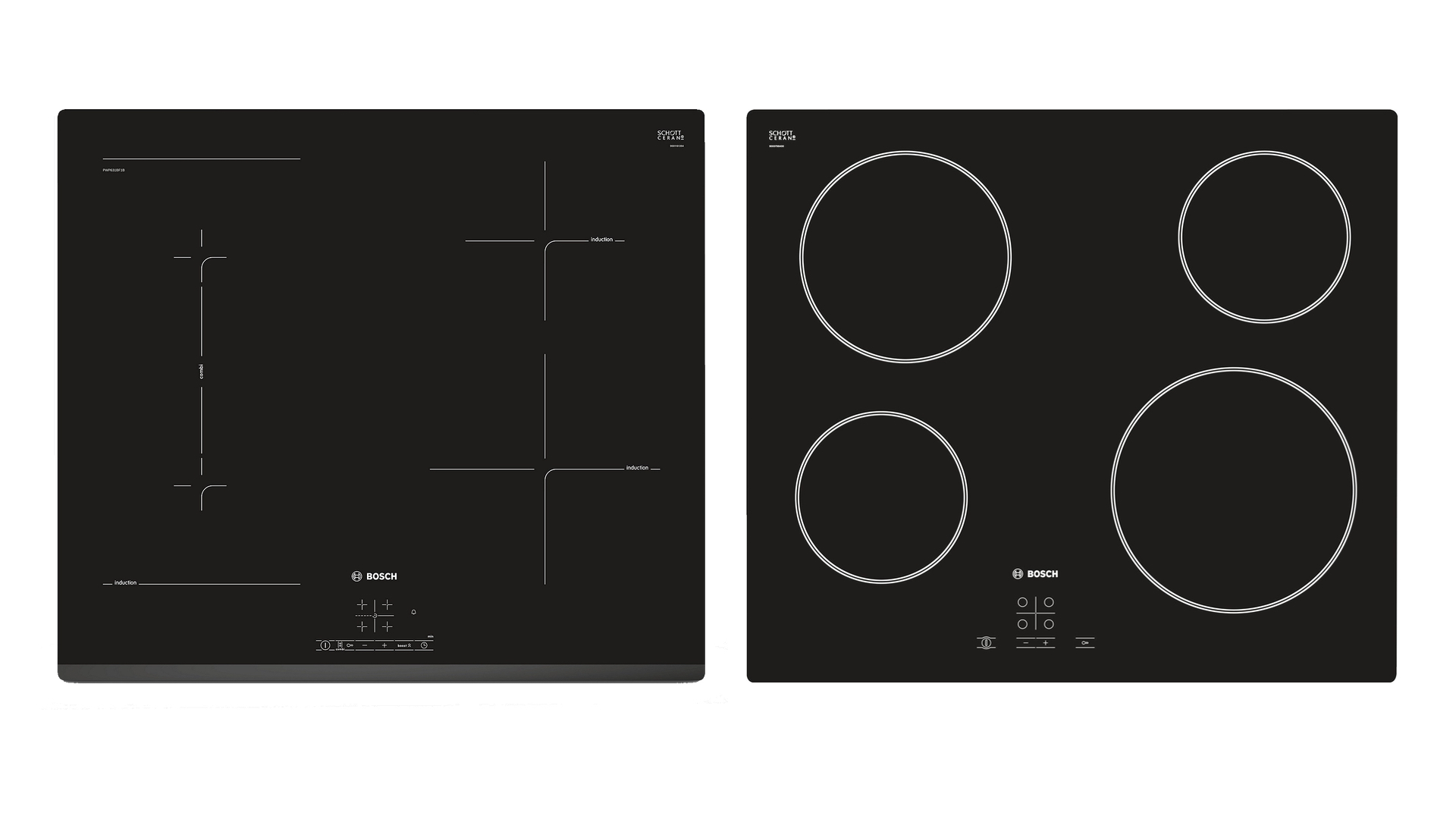

If you're looking at sleek modern new hob designs, you may be wondering about induction vs ceramic hobs, because they looks virtually identical. Both types are swathed in shiny ceramic-coated glass and both are often equipped with touch-sensitive controls.
It's easy to fall into the trap of thinking that ‘ceramic’ and 'induction' might just be different names for the same basic types of system – it happens in other areas of tech, after all. However, the two cooking systems couldn’t be further apart in terms of the technology used.
The best induction hobs feature an advanced and fast heating system based on magnetism, while ceramic hobs are essentially a fancy-looking update to the classic electric hob.
We’re here to put things straight and tell you everything you need to know about the two systems, and why you might choose one over the other.
Induction hob: how does it work?
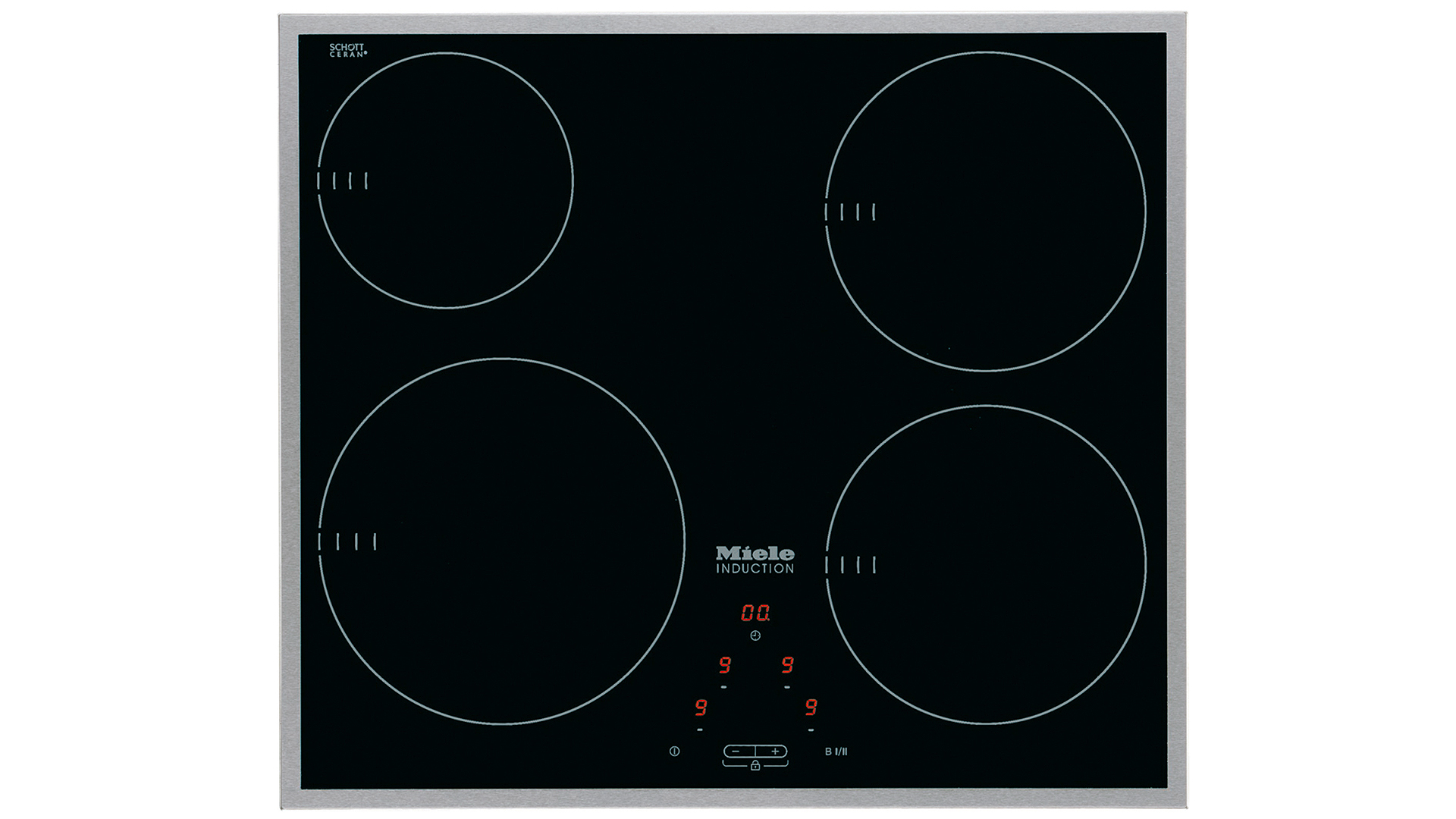
An induction hob looks largely the same whether it's on or off
First introduced in the 1980’s, induction hobs have taken the cooking world by storm and now account for about 35% of all hob purchases. On a scientific level, induction uses electromagnetic waves that agitate the electrons in ingredients, turning them hot in the process.
The higher the heat setting, the more the electrons are agitated until the ingredients are perfectly cooked and ready for the table. It’s an ingenious invention and one that’s as worthy of accolade as the dishwasher, the LED bulb and the, er, combine harvester.
Ceramic hob: how does it work?
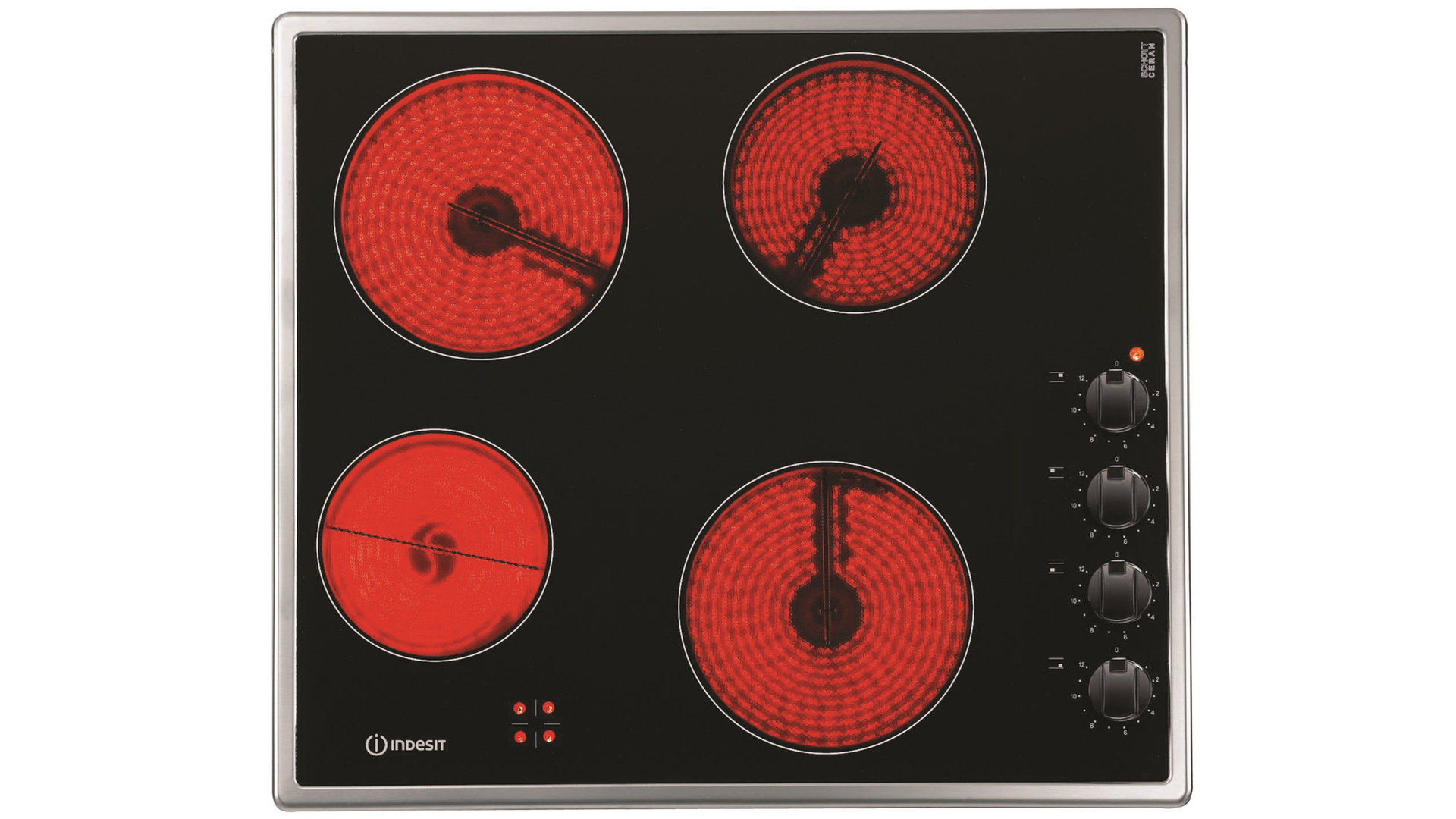
A ceramic hob uses a heating element positioned beneath a swathe of ceramic glass. When it's off, it looks just like an induction hob.
Although ceramic hobs look remarkably similar to their induction counterparts, the two systems are completely different. There is no magnetism involved in ceramic technology.
Sign up to the T3 newsletter for smarter living straight to your inbox
Get all the latest news, reviews, deals and buying guides on gorgeous tech, home and active products from the T3 experts
Instead, a circular heating element similar to those used in 1950s electric cooker hobs is placed beneath a swathe of ceramic glass. Turn it to full blast and you can easily see its glowing red-hot form beneath. It’s as simple as that.
Induction hob: advantages

The clean, svelte lines of a modern induction hob.
• Induction hobs are extremely responsive to temperature changes making them extremely reliable for all types of hob-based cooking. Furthermore, they are extremely fast at heating ingredients and will boil water quicker than a kettle.
• Induction hobs are exceedingly energy efficient because they lose just 15% of energy during the cooking process as opposed to at least 25% with ceramic hobs.
• While the most expensive type of hob to buy, induction hobs are generally considered the cheapest to run in the long term.
• Induction hobs are extremely safe to use because it’s the pan itself that heats the ingredients and not the hob. Indeed, the hob remains no hotter than a radiator immediately after use which makes it a much safer bet for households with children and cats. You can safely leave a dishcloth on the surface and it will never catch fire.
• Since all induction hobs are coated with a smooth glass/ceramic surface and usually equipped with touch-sensitive controls, they are an absolute breeze to keep clean. Simply wipe down with a damp cloth.
• Most budget to mid-priced induction hobs use specific ‘cooking zones’ which are designed for different pot dimensions. However, many new induction hobs now come with ‘bridging’ features which allow you to connect two zones together to form one larger zone. The very best – and most expensive – models now also include ‘flexinduction’ technology which allows the user to place pots and pans anywhere on the hob.
Induction hob: disadvantages
• Induction hobs can be expensive to buy though prices have dropped considerably recently.
• The process of induction requires pots and pans to be made with ferrous metal bases like steel and cast iron. You can check to see if your current cookware is compatible by placing a magnet on the base. If it sticks, it’s induction ready. If not, you’ll need to buy a new pot or pan.
• The glass ceramic surface of an induction hob can be scratched if pots are dragged from one zone to another. The surface is also prone to breakage if, say, a cast-iron Le Creuset pot is accidentally dropped. It’s therefore important to be thoughtful when positioning cookware.
• Induction hobs are expensive to repair. Unlike a gas hob which will continue to function even if one burner refuses to light, chances are that an electronic issue on an induction could scupper all cooking plans.
Ceramic hob: advantages
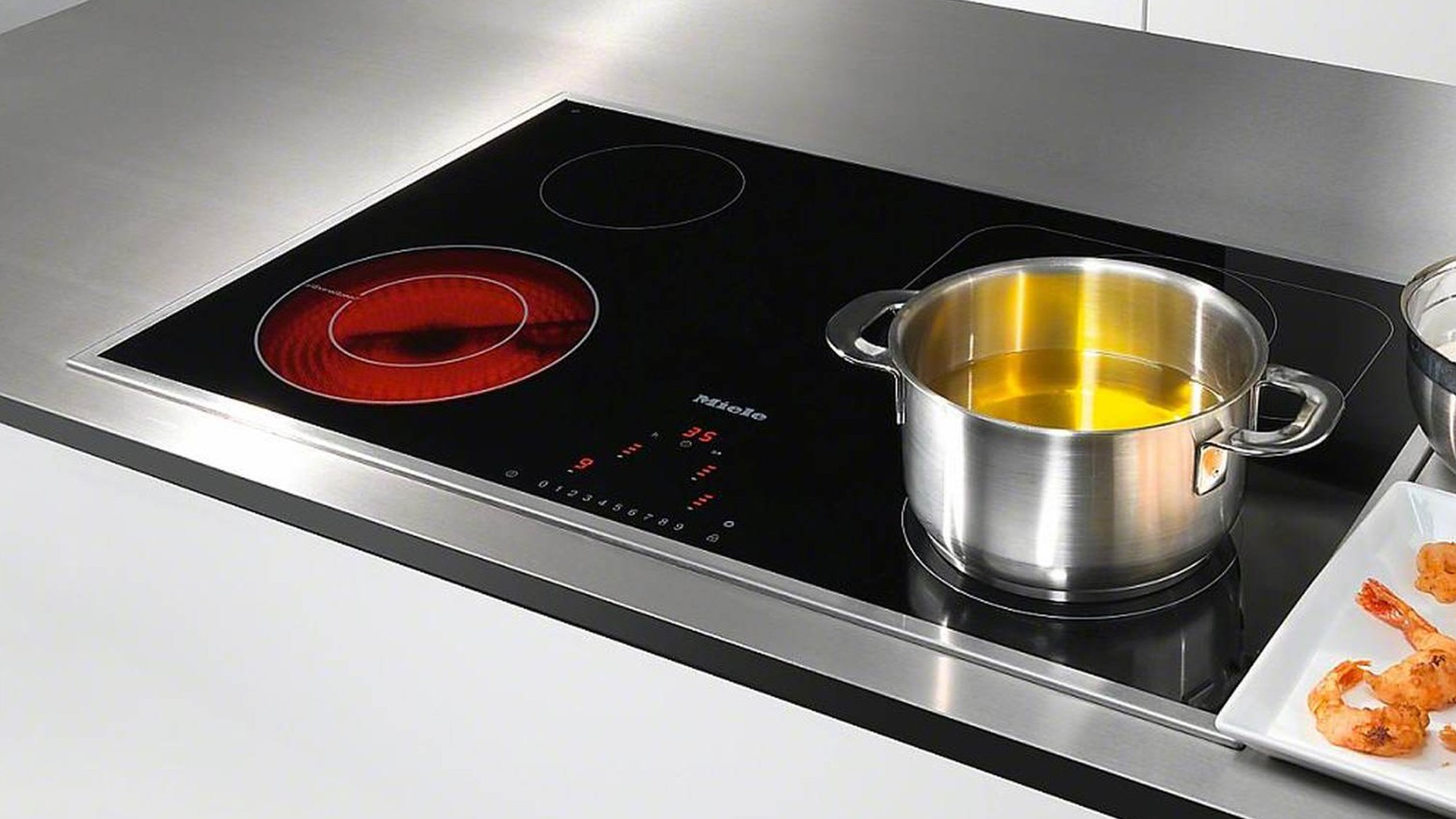
The similarly clean, svelte lines of a ceramic hob.
•Ceramic hobs are generally cheap to buy while looking good.
•You can use any type of cookware on them – they're just electric heat, after all.
•Like their induction equivalent, ceramic hobs are a cinch to clean, though you will have to wait for the surface to cool first.
• Higher-end ceramic hobs are generally more responsive than their cheaper brethren.
• The best ceramic hobs are equipped with expandable zones for larger, irregularly shaped pots.
Ceramic hob: disadvantages
• In general, ceramic hobs are agonisingly slow to respond to temperature controls – much slower than even gas. So slow that you may have to lift a boiling-over pot off the hob until the volcanic deluge subsides.
• Some ceramic hobs take ages to boil water – up to twenty minutes.
• Ceramic hobs can be very volatile. One minute it’s all going tickety boo, the next the onions have burned or the simmering has stopped.
• A ceramic hob’s zones are more efficient if used with the correct sized pans.
• Ceramic hobs are a lot more expensive to run than induction. They are also expensive to repair.
• Ceramic hobs are not nearly as safe to use as induction because the hob’s surface gets exceedingly hot and remains that way for several minutes after being turned off.
• Be wary of leaving any dish cloths on a ceramic hob because it could catch fire if you accidentally turn on one of the zones.
• Like induction hobs, ceramic glass models may be scratched by sliding pans.
Induction hob vs ceramic hob: verdict
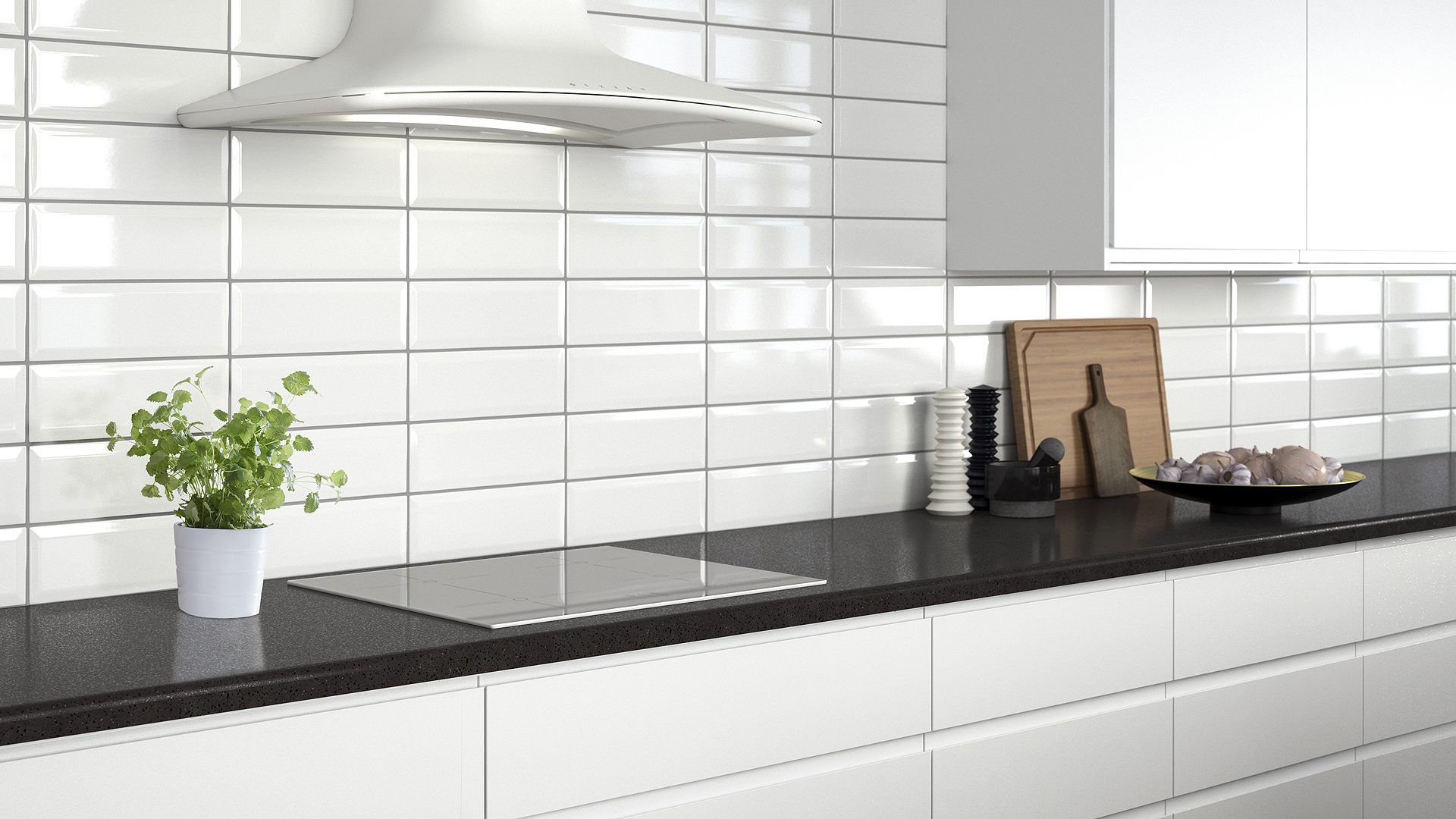
Both styles of hob add a touch of class to any kitchen.
You’ll have noticed that there aren’t many advantages to using a ceramic hob when compared to induction. This is because the technology is, to put it mildly, well past its sell-by date.
I unfortunately inherited an albeit cheap ceramic hob when I recently moved and I can’t wait to see the back of it. It’s insipidly slow to respond to my control input, unbelievably volatile with all ingredients and, to date, it’s set two tea-towels alight – thankfully while I was in the kitchen. I’m also terrified one of the cats will jump on board and melt its paws.
As an interim solution, I’ve since bought two portable inductions hobs, and they are a zillion times better than the slab I’ve currently been lumbered with. I’m frankly amazed that even the most prestigious companies like Miele, Bosch and Siemens still manufacturer ceramic options.
The moral of this article? Avoid a ceramic hob like the plague and immediately snap up the best induction hob you can afford. I guarantee you will never look back. Induction hobs are more controllable than even gas and they’re so much more environmentally friendly. They positively annihilate ceramic hobs for speed, efficiency, ease of use and, well, everything.
Derek (aka Delbert, Delvis, Delphinium, Delboy etc) specialises in home and outdoor wares, from coffee machines, white appliances and vacs to drones, garden gear and BBQs. He has been writing for more years than anyone can remember, starting at the legendary Time Out magazine – the original, London version – on a typewriter! He now writes for T3 between playing drums with his bandmates in Red Box (redboxmusic).
-
 The North Face and UNDERCOVER are back to zen-slam the trails with SOUKUU Season 4
The North Face and UNDERCOVER are back to zen-slam the trails with SOUKUU Season 4Meditative mountain gear? You better believe it – SOUKUU SS25 is part trailwear, part philosophy, and all fire.
By Matt Kollat Published
-
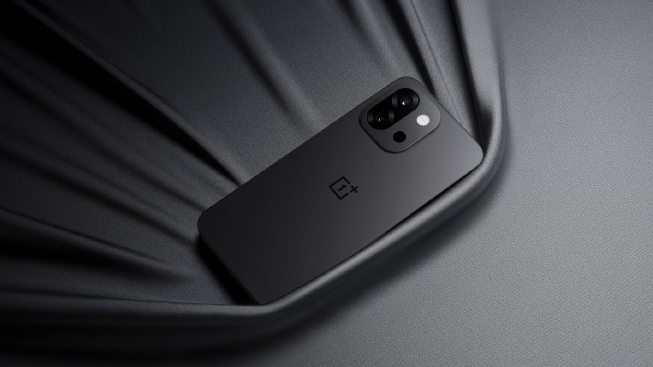 OnePlus 13T design leaked with iPhone-like design
OnePlus 13T design leaked with iPhone-like designA flurry of leaks have revealed the OnePlus 13T in the flesh
By Chris Hall Published